





PHOTO GALLERY

Photos by Len Blumin
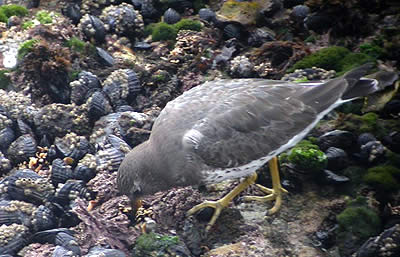
1. Surfbird
This winter migrant comes down from the mountains of the far north to feed at sea level on the rocky coastline. Often found with turnstones.
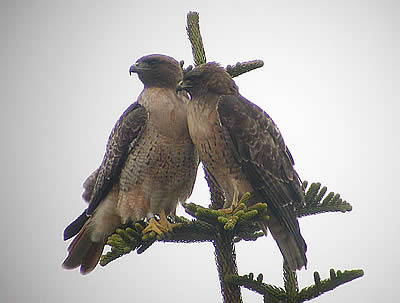
2. Red-Tailed Hawk pair (female on left)
Really enjoyed this pair. Dim light somewhat limiting (low shutter speeds), but lack of wind helped.
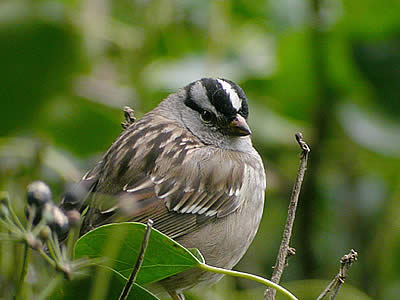
3. White-Crowned Sparrow
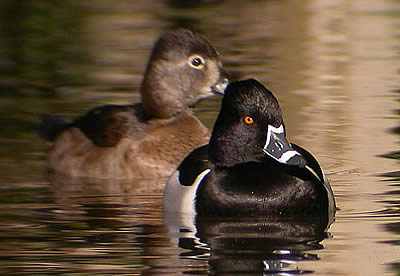
4. Ring-Necked Duck
The Ring-necked Duck, Aythya collaris, is always a treat to see as it winters on fresh water throughout the U.S. Although somewhat shy, we watched a group come pretty close, in part because I think they were trying to stay away from a River Otter that was cruising their pond in Tiburon, CA. That's the female in the background. The white ring on the tip of the male's bill and the ring at the base of the bill mark him unmistakeably. Another nice field mark is the upward pointing white spur at the front of his gray flank. You get a hint of his rather distinct profile as well, with a bump at the back of his head. And an orange eye to boot. Such a handsome fella!
The Genus Aythya contains about 12 species, 6 of which we see in the US. Besides the Ring-Necked Deck, we have the Greater and Lesser Scaups, Tufted Duck (uncommon), Redhead, and Canvasback. Most of the other Aythya species are Pochards (the Redhead has been called American Pochard).
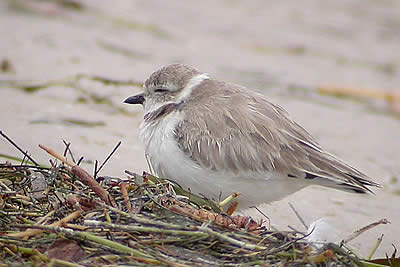
5. Florida: Piping Plover
The Piping Plover, Charadrius melodus, is named for his voice, which unfortunately we didn't get to hear, as this one was hunkered down in the wind and taking a nap. Taken at Fort Howard Park, Tarpon Springs, which is a great spot for a variety of shorebirds, including hundreds of Black Skimmers, gulls, and sandpipers.
The Piping Plover is much like our Snowy Plover, a small light gray plover with a small bill. Note that the Piping Plover's bill is a bit stubby, and the breastband is more complete than the Snowy's. His legs are yellow-orange, whereas the Snowy has gray legs.
Order: Charadrifomes (Oystercatchers, Plovers, Shorebirds, Gulls, etc.)
Family: Charadriidae (Lapwings and Plovers)
There are about 65 species in the Charadriidae family, including about 15 Lapwings (most have crests), and some 50 "plovers", which includes non-plover names like Killdeer and Dotterel. We have about 12 plover species in the US, but 3 are not seen often. That leaves about 9 "common" plovers, of which 7 can be found on the west coast. You'll have to go the Gulf Coast or East Coast to see the other two, which include Wilson's Plover and the Piping. We saw the Wilson's on the same beach, looking a lot like our Semi-palmated Plover, but with a thicker bill.
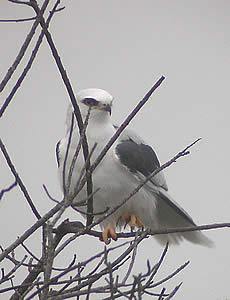
6. White-Tailed Kite
How lucky we are on the West Coast to see the elegant White-tailed Kite (Elanus leucurus) in such relative abundance. Here is one of a pair that we watched gathering nest materials on a little island in a pond along the San Rafael Shore, during a Jean Starkweather bird census of the area. (Jean leads a regular scheduled count along the San Rafael shore, and welcomes birders of every level to participate). Whether the White-tailed Kite (previously "Black-shouldered Kite") is simply resting on a snag, or hovering menacingly over a field mouse, it is one awesome and beautiful bird.
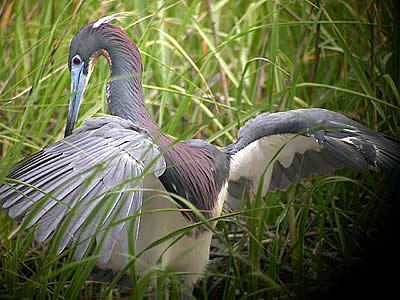
7. Tri-Colored Heron
Rather a plain heron through most of the year, but during the breeding season they add white head plumes and a beaufiful violet hue, with striking results. A very active feeder, but this one stopped to preen. South Padre Island, Texas, April 2005.
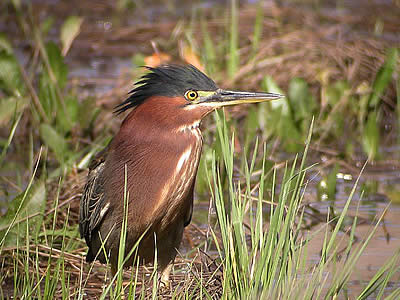
8. Green Heron
Went to Rush Creek preserve between the storms today. Spotted a Green Heron (Butorides virescens) right near the trailhead at Binford Road. He took off soon after I snapped this photo. Apparently the Green Heron does indeed have a crest, which is used during courtship displays (Hancock, in "Herons and Egrets of the World"). Or maybe it was just the wind, as photos before and after this show a normal sleek-looking dark cap. Or maybe he was trying his best to look like a Kingfisher. I love the chestnut color on this species. "Green" heron indeed!
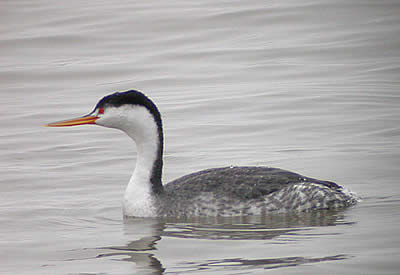
9. Clark's Grebe
When you go out with experienced birders you will soon find that they try to be precise about their identifications. Spotting a grebe with a long neck, they will call out "aechmophorus grebe". No, they are not trying to impress the crowd with their expertise in Latin, but rather indicating that they have seen a grebe in a certain genus, but are uncertain about the species. Usually the bird will then turn a bit and reveal a better profile, and someone will say "Clark's", or "Western".
This one popped up along the shoreline in San Rafael, during a survey with Jean Starkweather, and Lowell Sykes took about 1/2 second to say "Clark's Grebe". The bright yellow-orange bill is the tip-off, and the most reliable means of distinguishing a Clark's Grebe (Aechmophorus clarkii) from the closely related Western Grebe (Aechmophorus occidentalis), with its yellow-green bill. Not long ago they were considered to be the same species, but have been "split".
Two other pretty good field marks are shown in this somewhat fuzzy photo. The flank of the bird shows a fair amount of white mixed with the gray just above the waterline, whereas Western grebes are more gray, and perhaps darker. When we look at the eye we see that it is almost completely surrounded by white feathers, with a distinct white patch between the eye and the upper mandible of the bill ("eye in the white"). In the Western Grebe the patch in front of the eye is less white, and overall the eye appears to be surrounded by gray or black feathers. This field mark is more clear during the breeding season.
Lastly, the black feathers on the back of the neck may give a clue, but on this specimen it would have been misleading. The black stripe down the neck is said to be "thin" on Clark's Grebes, but as you can see in the second photo such was not the case here.
(aechmophorus = "spear-bearer", referring to the spear-like bill.
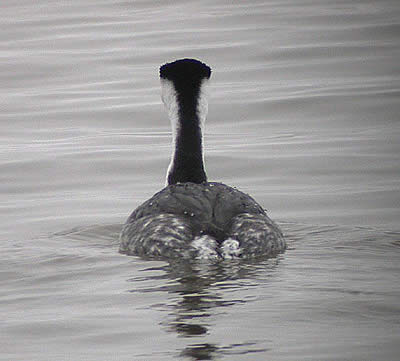
TOWHEE.NET: Harry Fuller, 820 NW 19th Street, McMinnville, OR 97128
website@towhee.net